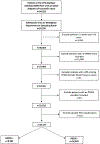Epidemiology and outcomes of multiple organ dysfunction syndrome following pediatric trauma
- PMID: 35358103
- PMCID: PMC9525450
- DOI: 10.1097/TA.0000000000003616
Epidemiology and outcomes of multiple organ dysfunction syndrome following pediatric trauma
Abstract
Background: Existing studies have found a low prevalence of multiple organ dysfunction syndrome (MODS) in pediatric trauma patients, typically applying adult criteria to single-center pediatric cohorts. We used pediatric criteria to determine the prevalence, risk factors, and outcomes of MODS among critically injured children in a national pediatric intensive care unit (PICU) database.
Methods: We conducted a retrospective cohort study of PICU patients 1 month to 17 years with traumatic injury in the Virtual Pediatric Systems, LLC database from 2009 to 2017. We used International Pediatric Sepsis Consensus Conference criteria to identify MODS on Day 1 of PICU admission and estimated the risk of mortality and poor functional outcome (Pediatric Overall/Cerebral Performance Category ≥3 with ≥1 point worsening from baseline) for MODS and for each type of organ dysfunction using generalized linear Poisson regression adjusted for age, comorbidities, injury type and mechanism, and postoperative status.
Results: Multiple organ dysfunction syndrome was present on PICU Day 1 in 23.1% of 37,177 trauma patients (n = 8,592), with highest risk among patients with injuries associated with drowning, asphyxiation, and abuse. Pediatric intensive care unit mortality was 20.1% among patients with MODS versus 0.5% among patients without MODS (adjusted relative risk, 32.3; 95% confidence interval, 24.1-43.4). Mortality ranged from 1.5% for one dysfunctional organ system to 69.1% for four or more organ systems and was highest among patients with hematologic dysfunction (43.3%) or renal dysfunction (29.6%). Death or poor functional outcome occurred in 46.7% of MODS patients versus 8.3% of patients without MODS (adjusted relative risk, 4.3; 95% confidence interval 3.4-5.3).
Conclusion: Multiple organ dysfunction syndrome occurs more frequently following pediatric trauma than previously reported and is associated with high risk of morbidity and mortality. Based on existing literature using identical methodology, both the prevalence and mortality associated with MODS are higher among trauma patients than the general PICU population. Consideration of early organ dysfunction in addition to injury severity may aid prognostication following pediatric trauma.
Level of evidence: Prognostic and Epidemiological; Level III.
Copyright © 2022 Wolters Kluwer Health, Inc. All rights reserved.
Conflict of interest statement
Figures


Similar articles
-
Day 1 multiple organ dysfunction syndrome is associated with poor functional outcome and mortality in the pediatric intensive care unit.Pediatr Crit Care Med. 2009 Sep;10(5):562-70. doi: 10.1097/PCC.0b013e3181a64be1. Pediatr Crit Care Med. 2009. PMID: 19741445 Free PMC article.
-
Children with chronic illness return to their baseline functional status after organ dysfunction on the first day of admission in the pediatric intensive care unit.J Pediatr. 2010 Jul;157(1):108-113.e1. doi: 10.1016/j.jpeds.2009.12.029. Epub 2010 Mar 10. J Pediatr. 2010. PMID: 20223474 Free PMC article.
-
Outcomes of Day 1 Multiple Organ Dysfunction Syndrome in the PICU.Pediatr Crit Care Med. 2019 Oct;20(10):914-922. doi: 10.1097/PCC.0000000000002044. Pediatr Crit Care Med. 2019. PMID: 31589198 Free PMC article.
-
The pediatric multiple organ dysfunction syndrome.Pediatr Crit Care Med. 2009 Jan;10(1):12-22. doi: 10.1097/PCC.0b013e31819370a9. Pediatr Crit Care Med. 2009. PMID: 19057438 Review.
-
Epidemiology of multiple organ dysfunction syndrome in critical surgical illness.Surg Infect (Larchmt). 2000 Fall;1(3):173-85; discussion 185-6. doi: 10.1089/109629600750018105. Surg Infect (Larchmt). 2000. PMID: 12594888 Review.
Cited by
-
Multiorgan Dysfunction Syndrome in Abusive and Accidental Pediatric Traumatic Brain Injury.Neurocrit Care. 2024 Jun;40(3):1099-1108. doi: 10.1007/s12028-023-01887-y. Epub 2023 Dec 7. Neurocrit Care. 2024. PMID: 38062303 Free PMC article.
-
Comprehensive Assessment of Mid-Regional Proadrenomedullin, Procalcitonin, Neuron-Specific Enolase and Protein S100 for Predicting Pediatric Severe Trauma Outcomes.Biomedicines. 2023 Aug 19;11(8):2306. doi: 10.3390/biomedicines11082306. Biomedicines. 2023. PMID: 37626802 Free PMC article.
-
Research status and advances in dexmedetomidine for sepsis‑induced multiple organ dysfunction syndrome (Review).Int J Mol Med. 2025 Jun;55(6):94. doi: 10.3892/ijmm.2025.5535. Epub 2025 Apr 17. Int J Mol Med. 2025. PMID: 40242975 Free PMC article. Review.
References
Publication types
MeSH terms
Grants and funding
LinkOut - more resources
Full Text Sources
Research Materials

